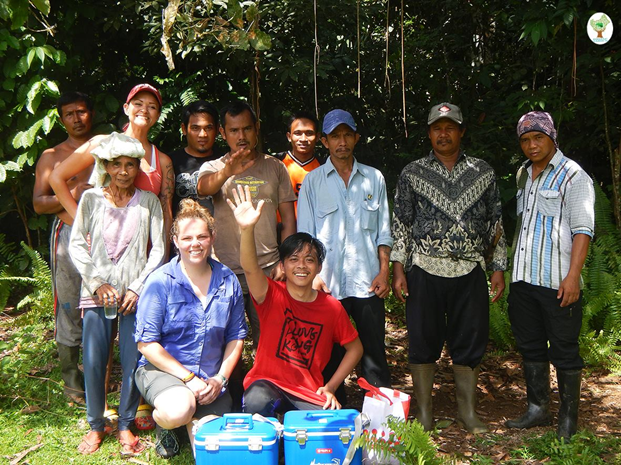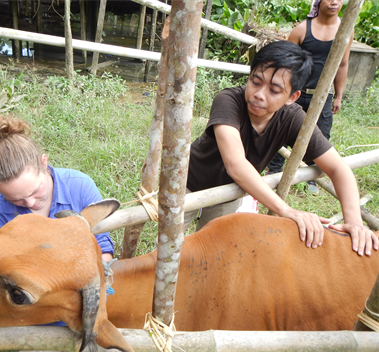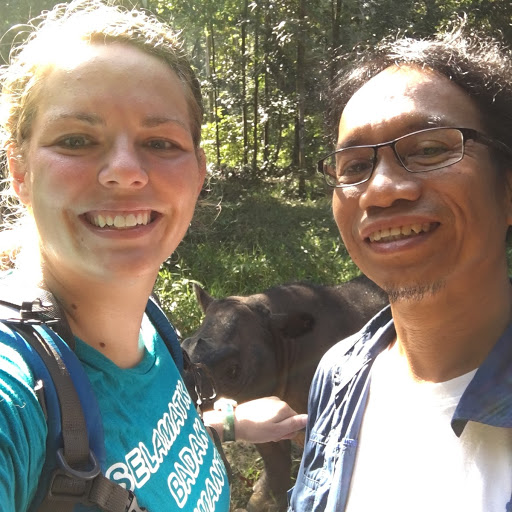This past summer, I traveled to Indonesia as part of Engaged Cornell. Engaged Cornell is a program that pairs together a graduate veterinary student and an undergraduate student for a summer research project. The program provided funding for four pairs of students to travel to Indonesia, the Congo, and Uganda. As part of team Indonesia, I also took a semester long intensive language course as well as a Conservation in Communities elective course.
My team went to East Kalimantan, the Indonesian province in Borneo. We were partnered with ALeRT (Aliansi Lestari Rimba Terpadu – The Alliance of Integrated Forest Conservation), a non-profit organization founded in 2009 by Dr. Marcellus Adi. ALeRT aims to protect the nature of Way Kambas National Park and encourage community development for sustainable living. In March 2017, ALeRT established a new office in Borneo to conduct disease surveillance and occupancy surveys of the Sumatran Rhinoceros found in East Kalimantan, in conjunction with WWF. The Sumatran Rhino is critically endangered, and was thought to be extinct in Borneo until it resurfaced between 2010-2013. There are an estimated 1-5 rhinos left in the region, and with continued habitat loss, the risk of death of these animals is high. WWF has been working in the region for a couple of years now, and plans to do a translocation of the rhino in the wild to the protected Kelian Forest. However, before the translocation can take place, a thorough evaluation of diseases in the current habitat and the protected forest is necessary to ensure that immunologically naïve rhinos are not exposed to new diseases in the protected Kelian Forest during the translocation.

We worked closely Dr. Aldino Yanuar, the ALeRT veterinarian at the field site in East Kalimantan. Our goal was to document the prevalence of gastrointestinal parasites and trypanosomes in cattle living in areas surrounding the potential habitat of the Sumatran rhinos. Because of the risk of cross-species transmission, establishing disease prevalence in cattle helps us to assess the risk to the rhinos. Since the ALeRT office was recently established, part of our job was to help Dr. Yanuar set up a small lab and help prepare sample collection protocol.
We spent a week at a time in remote villages that bordered the proposed habitat. Our partners had already begun choosing villages by sending members of the Social team to speak to villagers about whether they had seen any rhinos. Often, we didn’t have any prior information about how many cattle were found in each village. Some villages had just a few cattle, while others still maintained an abandoned government breeding program, and one village only kept swine. Because of this, it wasn’t always possible to anticipate what the day’s sample collection would be like.
 We built temporary stalls using wood cut down and plastic wrap, or whatever else was on hand. Many of the cattle were not used to handling, so collecting samples and administering vitamins required a lot of patience. In one set of villages, each temporary stall resulted in cows jumping over or under the sides to escape. I was completely out of my element when one village did not have any cattle, but did have swine. I had utilize what little I had learned in my curriculum about swine to collect the samples we needed. I made a lot of mistakes, but I learned a lot about myself, as well. At times, you must use what you have. If you run out of gloves, you do what you must do to get the samples. Often the roads were almost impassable, taking hours toget from one village to the next. There was seldom cell service or electricity. Our curriculum gives us a base on which to build our experiences, but the rest, the creative problem-solving, is up to us. I also had to face the reality that, in Borneo as in many other places in the world, animal welfare regulations are not as strict as they are in the United States. The pigs are kept in small wooded enclosures 5 feet above the ground, because of the flooding, and are fed one to two times daily. Often the pigs did not even have access to water. Many animals are kept alive long periods of time when they should be culled, because cows are thought of as a symbol of wealth and are saved for ceremonies such as weddings and funerals.
We built temporary stalls using wood cut down and plastic wrap, or whatever else was on hand. Many of the cattle were not used to handling, so collecting samples and administering vitamins required a lot of patience. In one set of villages, each temporary stall resulted in cows jumping over or under the sides to escape. I was completely out of my element when one village did not have any cattle, but did have swine. I had utilize what little I had learned in my curriculum about swine to collect the samples we needed. I made a lot of mistakes, but I learned a lot about myself, as well. At times, you must use what you have. If you run out of gloves, you do what you must do to get the samples. Often the roads were almost impassable, taking hours toget from one village to the next. There was seldom cell service or electricity. Our curriculum gives us a base on which to build our experiences, but the rest, the creative problem-solving, is up to us. I also had to face the reality that, in Borneo as in many other places in the world, animal welfare regulations are not as strict as they are in the United States. The pigs are kept in small wooded enclosures 5 feet above the ground, because of the flooding, and are fed one to two times daily. Often the pigs did not even have access to water. Many animals are kept alive long periods of time when they should be culled, because cows are thought of as a symbol of wealth and are saved for ceremonies such as weddings and funerals.
While in the area, we attended a traditional Dayak Funeral ceremony for a woman who had passed away in her sleep just days before we arrived. We ate with her family, and then watched them make the first sacrifice to help the dead cross into the afterlife. The sacrificial cow was used for meat over the following days. The second and final sacrifice, 7 days after her death, involved tying a water buffalo to a carved tree in the center of the field and releasing the water buffalo as men in two teams surrounded it. Every drop of blood spilled was a step closer to the afterlife, so the men in teams had knives and would stab the water buffalo as it attempted to get away. We watched as this part of the ceremony took place. Before the life of the water buffalo could be ended, a fight broke out between the two teams, so we were whisked away. This funeral ceremony is quite rare, and it was extremely difficult to see. We learn in class about behaviors exhibited by animals when they fear for their lives, and this water buffalo was terrified. We talk about animal welfare, and the USDA would by no means approve of this ceremony. However, it is part of the Dayak Tribe’s culture, deeply rooted in their history and spiritual beliefs – and who was I to say that this ceremony was wrong? Without understanding, we lose pieces of human history and diversity.
At each village we visited, I was astonished by the villagers’ kindness and willingness to share – gifts, food, and knowledge. The quote “Sometimes, those who give the most are the ones with the least to share” came to mind quite often. In one village, they started up the generator for us each night, and when we ran out of water to bathe in, rushed to the river to get us more water. I was gifted a handmade Dayak purse by one woman after spending the evening teaching English to the kids in the village. These amazing people had so little to give, and yet gave so much. At one point a farmer asked us, “why do doctors only come to check the animals and not us?” This statement still haunts me. The healthcare system in Indonesia is riddled with corruption. Much of the money is invested in Java and Jakarta for the roads. Though this is changing for the people in East Kalimantan, I wonder if it is changing fast enough. And as the needs of people continue to increase, it only means that the forest will get smaller. Many people still rely on the forest. Some villagers see the forest as an endless possibility. Other are afraid of the creatures it holds, and still others are unconcerned about the forest, because it is palm oil and rubber that provide for their families. Conservation of animals is so closely intertwined with the people surrounding these flagship species like the rhinoceros. I remember riding the motorcycle from one village to the next, seeing many people with guns going hunting. Even in the protected Kelian forest, there was evidence of people. A bearded pig had a distal limb amputation from a snare. We ate monitor lizard in a village close to the Kelian forest, after a villager offered us some of his prized meal. The question is, how can we really get people involved in protecting the forest and animals, while at the same time maintaining a sustainable economy?
To explain the relationship between America and Indonesia, you must understand the complex history between the two nations. Indonesia was originally a Dutch colony for hundreds of years. The Dutch established a caste system and controlled all portions of the government. In 1945, after a complex role in World War II and a period of Japanese occupation, Indonesia proclaimed its independence. America brokered the deal: for their independence, Indonesia would pay the Dutch what would be about 150 billion dollars today. The country was left poor, with its natural resources exploited. In the 1960s, communism began to take hold of Indonesia. At the height of the Cold War, the United States intervened, and the CIA effectively ran a shadow government. With the backing of the United States, Indonesian General Suharto took control, and murdered high-ranking members of the military, blaming it on communists. The subsequent anti-communist purge led to the genocide of 300,000-400,000 people. Indonesia continued to grow and develop economically, but Suharto’s administration was widely suspected of corruption. In 1998, Suharto resigned, and Indonesia became a democracy. In 2010, the net worth Indonesia’s vast oil and mineral reserves was over 95 billion dollars, yet the government only operated on 19 billion dollars that year. The remaining 66 billion dollars in revenue from Indonesia’s natural resources went to American, Australian and Singaporean companies.
So with this history of colonialization and even more recent neo-colonialism, what is our role as conservationists? That is a question I still struggle to answer. The clear majority of Americans will never know what it is like to grow up in a developing country. We might have preconceived notions about how easy it would be for someone to just stop poaching, or to build a better road. To just simply stop the hunting of prized animals such as elephants, even though it can provide some income to poor villages. To see an elephant in chains and proclaim that such treatment is inhumane. To judge someone who traps a pangolin, despite not even knowing the laws preventing it. To say that a farmer needs to provide his cows with more calcium, while the farmers must prioritize their children’s needs for the same mineral. Even as veterinarians, we are taught that when an animal presents with a problem, we fix that problem. Practice is rarely so simple. We will learn later in our careers how complicated that can be, based upon the client and their financial needs. We live a sheltered life in veterinary school, but programs like Engaged Cornell and Expanding Horizons give us glimpses of the “real world.” My experience taught me how the world really operates, and left me with more questions than answers when it comes to the realities of conservation, and how to implement change. Even now, words don’t do my experience and the people I met any justice.
Working with ALeRT helped me to see that my role, and maybe our roles, are not to march in as crusaders, to try to get people to stop what they have been doing for years. ALeRT was run entirely by Indonesians, and they employed people with connections to the Dayak tribe. Our role is to empower and educate people who can utilize that knowledge, along with their understanding of the culture, to make long lasting impacts for people, the rhinos, and the environment. I am proud and humbled to be a part of Engaged Cornell because it is a program that augments the work that Indonesians such as the illustrious Dr. Marcel Adi and Dr. Yanuar are doing to protect the environment.
Many of my questions remained unanswered, swirled in the reality that I am just one person. With clinical rotations looming in my immediate future, I feel the frustration of being faced with these questions and not being able to do much right now. However, I have learned that the integration of multidisciplinary roles is essential to effectively enact long-lasting change. I believe that One Health is going to change the world, but it will be a long and arduous road to creatively solve major issues facing the planet, and asking the right questions is just the beginning. One area I would like to see improve is the sharing of information. There was a lot of prior research conducted in Indonesia that I could not access without knowing some of the language. Speaking with the head of WWF Indonesia, I know he and other people are working hard to translate what they know, to make it available to people in English-speaking countries. Indonesian researchers would benefit from translations, as well. It is just a slow process, and many species don’t have that time.
For more information on neocolonialism in Indonesia, check out this article.
—-
ABOUT THE AUTHOR
Eden Stark is a third year veterinary student.


